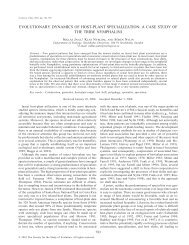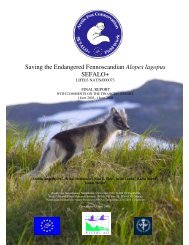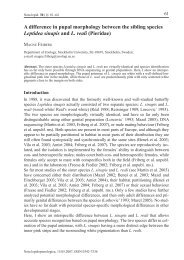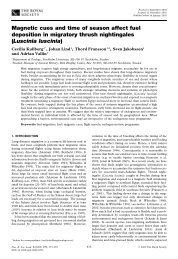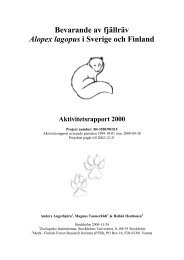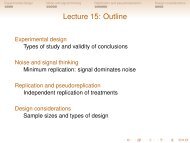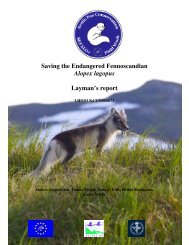The conservation of Fennoscandian arctic foxes - Stockholms ...
The conservation of Fennoscandian arctic foxes - Stockholms ...
The conservation of Fennoscandian arctic foxes - Stockholms ...
Create successful ePaper yourself
Turn your PDF publications into a flip-book with our unique Google optimized e-Paper software.
ut we saw no effect <strong>of</strong> hunting (p=0.54; Table 5). We also tested if a reproduction previous year atthe same den had an effect which could have indicated that maternal quality or territory quality wasimportant, but found no effect (p=0.46).Table 5. <strong>The</strong> effect <strong>of</strong> hunting, feeding, rodent phase and reproduction last year on <strong>arctic</strong> fox litter size.Source <strong>of</strong> variation SS Df MS F pFeeding (yes-no) 51.6 1 51.6 6.60 0.017Rodent phase (high-low) 29.6 1 29.6 3.79 0.064Reproduction last year (yes-no) 4.4 1 4.4 0.57 0.459Hunting (yes-no) 3.1 1 3.1 0.39 0.538Error 172.0 22 7.8 0.064141210Litter size86420Extra feedingNo feedingFigure 8. Arctic fox litter size ±SE in relationship to the experimental supplemental feeding, F(1,22) = 6.60,p=0.017.Behavioural responseWe have earlier showed that <strong>arctic</strong> <strong>foxes</strong> avoid red <strong>foxes</strong> during reproduction (Tannerfeldt et al.,2002). Genetic analyses on faecal samples (Dalén, Götherström & Angerbjörn, 2004) were used todetermine the spatial and temporal distribution <strong>of</strong> <strong>arctic</strong> and red <strong>foxes</strong> on the mountain tundra. Aninitial study (Dalén et al., 2004) found that red <strong>foxes</strong> inhabit mountain areas <strong>of</strong> intermediate altitudeduring both summer and winter. Arctic <strong>foxes</strong> inhabited the same altitudes as red <strong>foxes</strong> during winter,but seemed to move to higher elevations during summer (Tukey post-hoc test p = 0.01; Figure 9.).One prediction from this hypothesis is that <strong>arctic</strong> <strong>foxes</strong> should stay at the same, more productive,altitude if red <strong>foxes</strong> are absent. To test this, we investigated the spatio-temporal distribution <strong>arctic</strong> foxfaeces in the Helags mountain area, where red <strong>foxes</strong> have been experimentally removed as part <strong>of</strong> theSEFALO+ <strong>conservation</strong> program. <strong>The</strong> results showed that there was no altitudinal difference betweenseasons in the area where red <strong>foxes</strong> were culled (Tukey post-hoc test p = 0.59; Figure 10.).12



